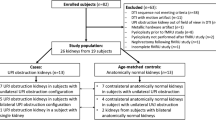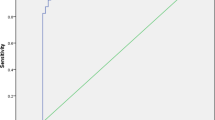Abstract
Background
Diffusion-weighted imaging plays a key role in the imaging of acute pyelonephritis by MRI. However the use of respiratory triggering is challenging and time-consuming in children. Diffusion tensor imaging without respiratory triggering might provide satisfying images of the moving kidneys.
Objective
To compare mean diffusivity diffusion tensor images obtained with free breathing with diffusion-weighted images obtained with respiratory triggering.
Materials and methods
Thirty-one children with suspected acute pyelonephritis underwent axial diffusion tensor imaging acquisition with free breathing and axial and coronal diffusion-weighted imaging acquisitions with respiratory triggering. We compared image quality and detection of nephritis between the two sequences.
Results
Diffusion tensor imaging demonstrated agreement with diffusion-weighted imaging in all cases, with no difference in the detection of nephritis areas. The image quality was significantly better with diffusion tensor imaging (P<0.01).
Conclusion
Diffusion tensor imaging could replace diffusion-weighted imaging for diagnosis of acute pyelonephritis.


Similar content being viewed by others
References
Subcommittee on Urinary Tract Infection, Steering Committee on Quality Improvement and Management, Roberts KB (2011) Urinary tract infection: clinical practice guideline for the diagnosis and management of the initial UTI in febrile infants and children 2 to 24 months. Pediatrics 128:595–610
Preda I, Jodal U, Sixt R et al (2010) Value of ultrasound in evaluation of infants with first urinary tract infection. J Urol 183:1984–1988
Riccabona M, Avni FE, Blickman JG et al (2008) Imaging recommendations in paediatric uroradiology: minutes of the ESPR workgroup session on urinary tract infection, fetal hydronephrosis, urinary tract ultrasonography and voiding cystourethrography, Barcelona, Spain, June 2007. Pediatr Radiol 38:138–145
Vivier PH, Sallem A, Beurdeley M et al (2014) MRI and suspected acute pyelonephritis in children: comparison of diffusion-weighted imaging with gadolinium-enhanced T1-weighted imaging. Eur Radiol 24:19–25
Faletti R, Cassinis MC, Fonio P et al (2013) Diffusion-weighted imaging and apparent diffusion coefficient values versus contrast-enhanced MR imaging in the identification and characterisation of acute pyelonephritis. Eur Radiol 23:3501–3508
Hasan KM, Alexander AL, Narayana PA (2004) Does fractional anisotropy have better noise immunity characteristics than relative anisotropy in diffusion tensor MRI? An analytical approach. Magn Reson Med 51:413–417
Furman-Haran E, Grobgeld D, Nissan N et al (2016) Can diffusion tensor anisotropy indices assist in breast cancer detection? J Magn Reson Imaging 44:1624–1632
Majd M, Nussbaum Blask AR, Markle BM et al (2001) Acute pyelonephritis: comparison of diagnosis with 99mTc-DMSA, SPECT, spiral CT, MR imaging, and power Doppler US in an experimental pig model. Radiology 218:101–108
Jones RA, Grattan-Smith JD (2003) Age dependence of the renal apparent diffusion coefficient in children. Pediatr Radiol 33:850–854
Acknowledgements
We are grateful to Nikki Sabourin-Gibbs, Rouen University Hospital, for her help with editing the manuscript.
Author information
Authors and Affiliations
Corresponding author
Ethics declarations
Conflicts of interest
None.
Rights and permissions
About this article
Cite this article
Lair, M., Renaux-Petel, M., Hassani, A. et al. Diffusion tensor imaging in acute pyelonephritis in children. Pediatr Radiol 48, 1081–1085 (2018). https://doi.org/10.1007/s00247-018-4146-4
Received:
Revised:
Accepted:
Published:
Issue Date:
DOI: https://doi.org/10.1007/s00247-018-4146-4




